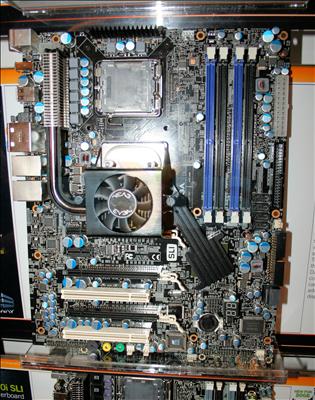EVGA's nForce 780i SLI better than the reference - features hybrid cooling
|
by Tarinder Sandhu
on 9 January 2008, 15:51
Tags:
EVGA
Quick Link: HEXUS.net/qak2y
Add to My Vault:
|
|
Showcasing its in-house-designed version of the recently-released nForce 780i SLI chipset for Intel processors, EVGA was keen to point out that it had improved on the NVIDIA reference design in a number of ways.
Supporting quad-core 45nm processors and providing PCIe 2.0 via the NF200 ASIC that's hidden under the large northbridge heatsink, we know that the nForce DDR2-supporting 780i adds x16 PCIe 2.0 for both the primary (top) and secondary (bottom) slots. The middle slot, used for three-way SLI, is run off the southbridge.
EVGA has an eight-phase PWM on its nForce 780i SLI FTW model. It also adds a further couple of SATA ports when compared to the reference design and caters for the enthusiast with a proper clear-CMOS button rather than a jumper. The board is equipped with all-solid capacitors, too.
It will also feature hybrid cooling that augments the traditional air cooling with the waterblock you see. The design isn't finished, and we expect to see different-sized barbs on the final revision.
EVGA has recently expanded its BIOS team by hiring a bunch of ex-EPoX enginners. As such, one of the first fruits of their labours will be a slew of enthusiast-friendly BIOS-related options not present in the reference design, we were told. The 'FTW is coming in late February. No word on pricing, though.
All HEXUS CES 2008 content















